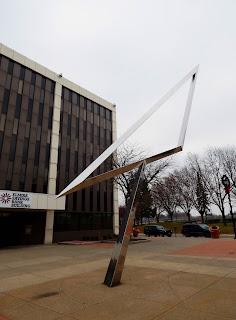by
Rachel Dworkin, Archivist
Basketball was invented on a rainy December day in 1891 by
Dr. James Naismith, director of physical education at the YMCA Training School
in Springfield, Massachusetts. After
much experimentation and tweaking, the first official game was played at the
YMCA in Albany, New York on January 20, 1892.
Over the next decade, the YMCA worked hard to spread their new
sport. The first basketball game in
Chemung County was played in the Elmira YMCA gymnasium in 1898 and the city’s
first league was established in 1900. It
initially consisted of four teams – the Easters, the Northers, the Southers,
and the Westers – but new teams were created as the sport gained in popularity.
 |
| YMCA Easters featuring Gene Banker, Ed Deister, Herman Lamb, Ralph Sartor, and some other people, ca. 1900 |
In 1917,
the Neighborhood House organized the semi-pro NH City League which ran until
the 1950s. The Neighborhood House
Currents, the YMCA Blackhawks, and the Eclipse Machines were the powerhouses of
the league, but there were nearly a dozen other teams sponsored by local
businesses and organizations as well.
Teams played before packed houses at the Elmira Armory. Chemung County teams also participated in
regional leagues. The YMCA Blackhawks,
Neighborhood House Currents, St. Casimir’s Eagles and Horseheads Merchants all
joined the New York-Penn League when it was established in 1937. Some later leagues include the Regional
League (early 1940s); the YMCA Blackhawk League (late 1940s- mid 1960s); and
the Southern Tier Basketball Association (1950s). Elmira was even home to a professional team
which briefly played for the NY-P Pro League in the 1930s and the American
Basketball League in the 1950s.
 |
| Eclipse Machines, 1942-3, featuring Coach Jim Deegan, Jack asey, Leon Popelewski, Leo Makovitch, Tom Sabran. Jack Biggs, Bill Cieri, Bill Young, Bud Sink and John Gableman. |
 |
| Neighborhood House Currents, 1944 champions, featuring Nelson Collins, Bruce Hurst, Roland & Howard Coleman, Tommy Reid, Jim Snowden, Nap Shepard, and Bill Lewis. |
Beginning
in the 1920s, the YMCA and the Neighborhood House hosted post-season
tournaments and exhibition games. These
tournaments not only featured the usual local talent, but also attracted
college players and teams from around the state. Most of these tournaments petered out in the
1970s due, in part, to NCAA rule changes about what players could do in the off
season and the fact fans could now watch the pros on TV.
 |
| Program for exhibition game between EFA Blue Devils (featuring Ernie Davis) and the Syracuse Devils, 1958 |
Of course,
this blog barely scratches the surface in terms of amateur basketball. All of the local public high schools have
teams and, over the years, there have been a number of youth leagues as
well. Then there are the factory teams
and women’s leagues. They are, however,
all stories for another day.
 |
| Neighborhood House Youth League champions for all age divisions, 1934-5. |









